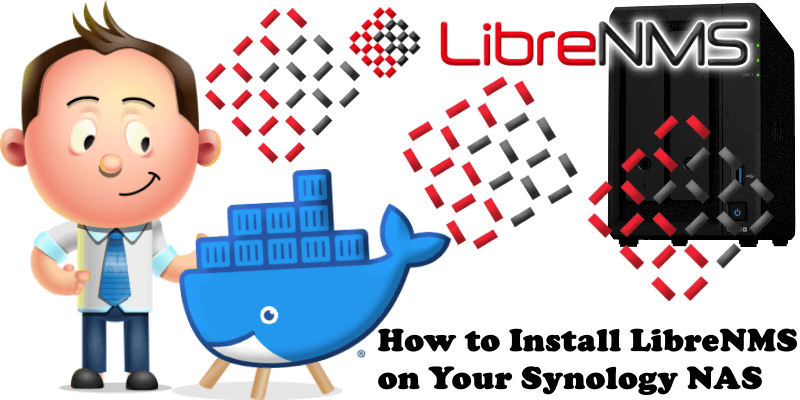
LibreNMS is an auto-discovering PHP/MySQL/SNMP based network monitoring which includes support for a wide range of network hardware and operating systems including Cisco, Linux, FreeBSD, Juniper, Brocade, Foundry, HP and many more. In this step by step guide I will show you how to install LibreNMS on your Synology NAS using Docker & Portainer.
This guide works perfectly with the latest LibreNMS v25.11.0 release.
STEP 1
Please Support My work by Making a Donation.
STEP 2
Install Portainer using my step by step guide. If you already have Portainer installed on your Synology NAS, skip this STEP. Attention: Make sure you have installed the latest Portainer version.
STEP 3
Make sure you have a synology.me Wildcard Certificate. Follow my guide to get a Wildcard Certificate. If you already have a synology.me Wildcard certificate, skip this STEP.
STEP 4
Go to Control Panel / Login Portal / Advanced Tab / click Reverse Proxy. Follow the instructions in the image below.
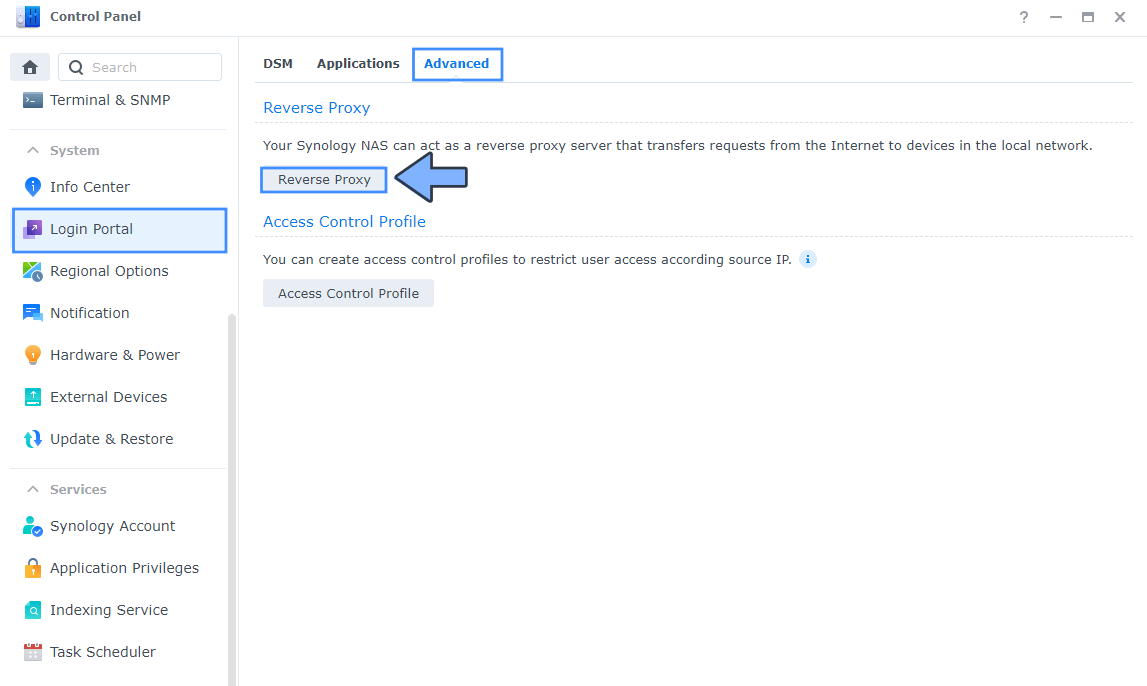
STEP 5
Now click the “Create” button. Follow the instructions in the image below.
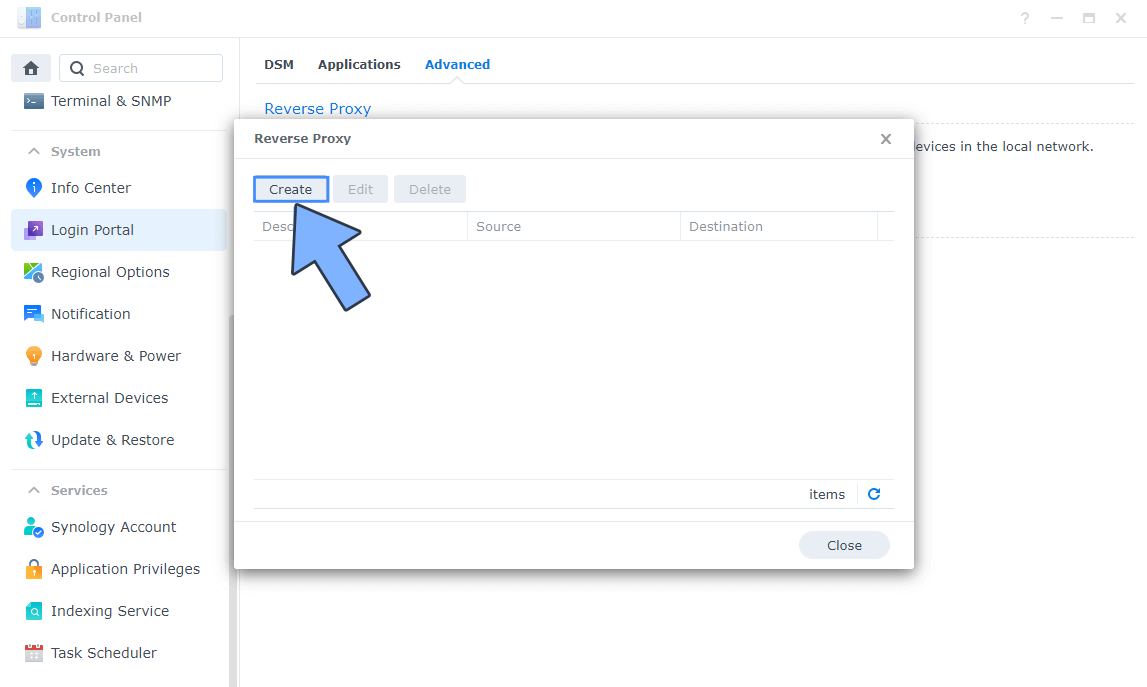
STEP 6
After you click the Create button, the window below will open. Follow the instructions in the image below.
On the General area, set the Reverse Proxy Name description: type in LibreNMS. After that, add the following instructions:
Source:
Protocol: HTTPS
Hostname: librenms.yourname.synology.me
Port: 443
Check Enable HSTS
Destination:
Protocol: HTTP
Hostname: localhost
Port: 5080
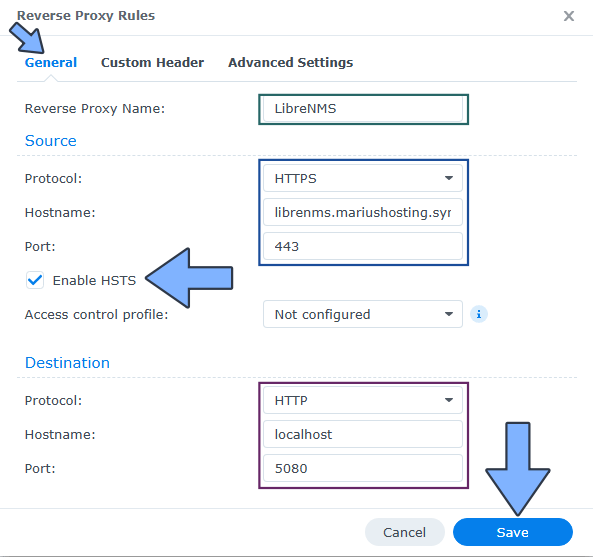
STEP 7
On the Reverse Proxy Rules click the Custom Header tab. Click Create and then, from the drop-down menu, click WebSocket. After you click on WebSocket, two Header Names and two Values will be automatically added. Click Save. Follow the instructions in the image below.

STEP 8
Go to Control Panel / Network / Connectivity tab/ Check Enable HTTP/2 then click Apply. Follow the instructions in the image below.
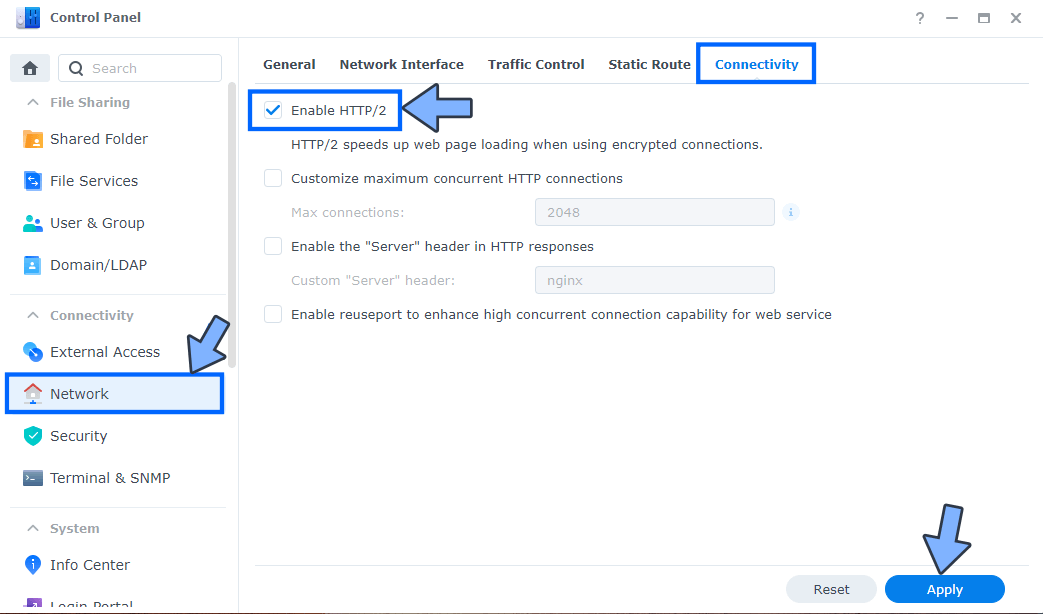
STEP 9
Go to Control Panel / Security / Advanced tab/ Check Enable HTTP Compression then click Apply. Follow the instructions in the image below.
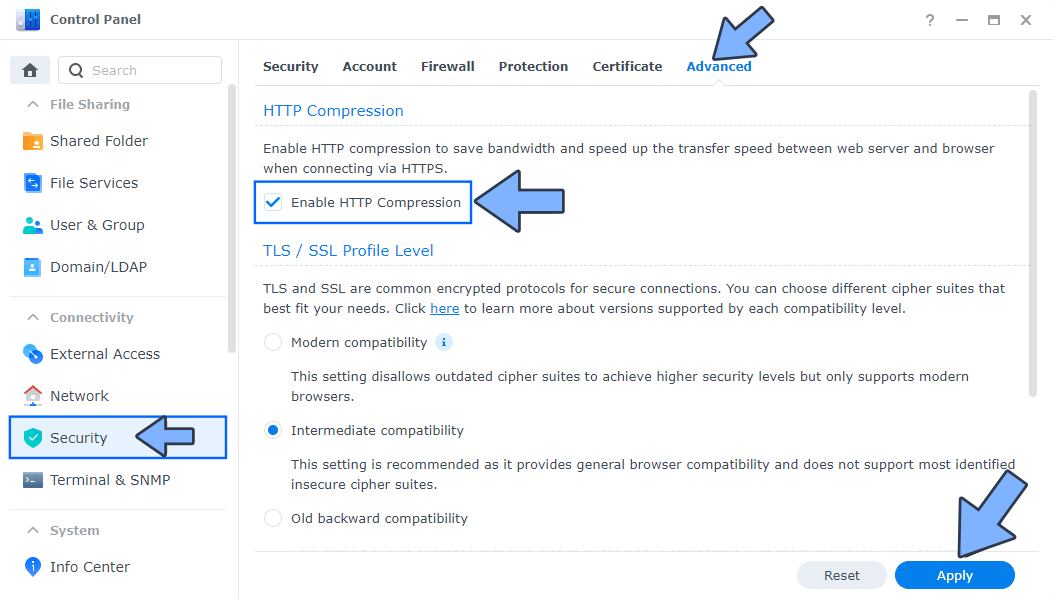
STEP 10
Go to File Station and open the docker folder. Inside the docker folder, create one new folder and name it librenms. Follow the instructions in the image below.
Note: Be careful to enter only lowercase, not uppercase letters.
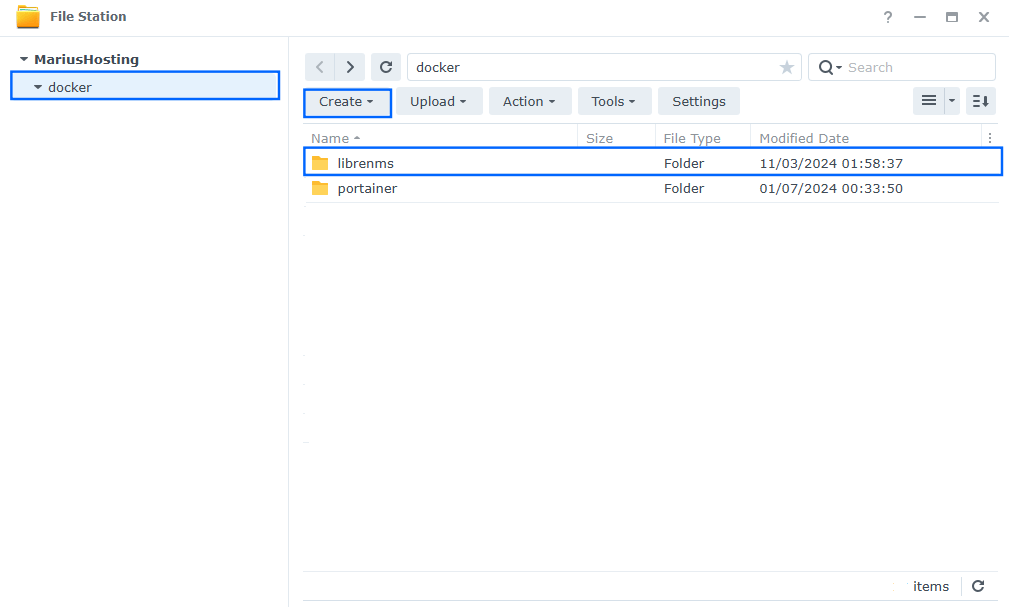
STEP 11
Now create three new folders inside the librenms folder that you have previously created at STEP 10 and name them data, db, redis. Follow the instructions in the image below.
Note: Be careful to enter only lowercase, not uppercase letters.
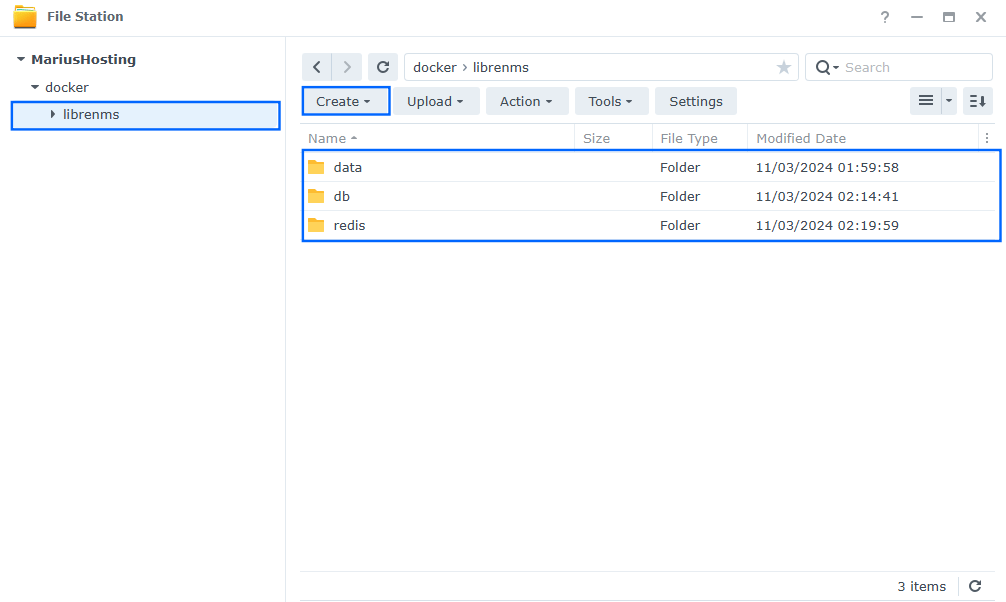
STEP 12
Follow my step by step guide on how to activate SMTP for your Gmail account. This step is mandatory. Note: If you don’t want to use the easiest way for SMTP with Google and you already have SMTP details from your own Mail Server, you can just skip this STEP and use your personalized email SMTP details instead.
STEP 13
Log into Portainer using your username and password. On the left sidebar in Portainer, click on Home then Live connect. Follow the instructions in the image below.

On the left sidebar in Portainer, click on Stacks then + Add stack. Follow the instructions in the image below.

STEP 14
In the Name field type in librenms. Follow the instructions in the image below.
services:
db:
image: mariadb:11.4-noble #LTS Long Time Support Until May 29, 2029.
container_name: LibreNMS-DB
command:
- mariadbd
- --innodb-file-per-table=1
- --lower-case-table-names=0
- --character-set-server=utf8mb4
- --collation-server=utf8mb4_unicode_ci
volumes:
- /volume1/docker/librenms/db:/var/lib/mysql:rw
environment:
TZ: Europe/Bucharest
MARIADB_RANDOM_ROOT_PASSWORD: yes
MARIADB_DATABASE: librenms
MARIADB_USER: librenmsuser
MARIADB_PASSWORD: librenmspass
restart: on-failure:5
redis:
image: redis:7.2-alpine
container_name: LibreNMS_REDIS
healthcheck:
test: ["CMD-SHELL", "redis-cli ping || exit 1"]
volumes:
- /volume1/docker/librenms/redis:/data:rw
environment:
TZ: Europe/Bucharest
restart: on-failure:5
msmtpd:
image: crazymax/msmtpd:latest
container_name: LibreNMS_MSMTPD
environment:
SMTP_HOST: smtp.gmail.com
SMTP_PORT: 587
SMTP_TLS: on
SMTP_STARTTLS: on
SMTP_TLS_CHECKCERT: on
SMTP_AUTH: on
SMTP_USER: Your-own-gmail-address
SMTP_PASSWORD: Your-own-app-password
SMTP_FROM: Your-own-gmail-address
restart: on-failure:5
librenms:
image: librenms/librenms:latest
container_name: LibreNMS
healthcheck:
test: ["CMD-SHELL", "nc -z 127.0.0.1 8000 || exit 1"]
interval: 10s
timeout: 5s
retries: 3
start_period: 90s
hostname: librenms
cap_add:
- NET_ADMIN
- NET_RAW
ports:
- target: 8000
published: 5080
protocol: tcp
depends_on:
- db
- redis
- msmtpd
volumes:
- /volume1/docker/librenms/data:/data:rw
environment:
TZ: Europe/Bucharest
PUID: 1026
PGID: 100
SESSION_SECURE_COOKIE: true
DB_HOST: db
DB_NAME: librenms
DB_USER: librenmsuser
DB_PASSWORD: librenmspass
DB_TIMEOUT: 120
MEMORY_LIMIT: 512M
MAX_INPUT_VARS: 1000
UPLOAD_MAX_SIZE: 128M
OPCACHE_MEM_SIZE: 128
REAL_IP_FROM: 0.0.0.0/32
REAL_IP_HEADER: X-Forwarded-For
LOG_IP_VAR: remote_addr
CACHE_DRIVER: redis
SESSION_DRIVER: redis
REDIS_HOST: redis
LIBRENMS_SNMP_COMMUNITY: librenmsdocker
LIBRENMS_WEATHERMAP: false
LIBRENMS_WEATHERMAP_SCHEDULE: "0 0 */2 * * *" # Schedule WeatherMAP every 2 hours
restart: on-failure:5
dispatcher:
image: librenms/librenms:latest
container_name: LibreNMS-DISPATCHER
hostname: librenms-dispatcher
cap_add:
- NET_ADMIN
- NET_RAW
depends_on:
- librenms
- redis
volumes:
- /volume1/docker/librenms/data:/data:rw
environment:
TZ: Europe/Bucharest
PUID: 1026
PGID: 100
DB_HOST: db
DB_NAME: librenms
DB_USER: librenmsuser
DB_PASSWORD: librenmspass
DB_TIMEOUT: 120
DISPATCHER_NODE_ID: dispatcher1
SIDECAR_DISPATCHER: 1
MEMORY_LIMIT: 512M
MAX_INPUT_VARS: 1000
UPLOAD_MAX_SIZE: 128M
OPCACHE_MEM_SIZE: 128
REAL_IP_FROM: 0.0.0.0/32
REAL_IP_HEADER: X-Forwarded-For
LOG_IP_VAR: remote_addr
CACHE_DRIVER: redis
SESSION_DRIVER: redis
REDIS_HOST: redis
LIBRENMS_SNMP_COMMUNITY: librenmsdocker
LIBRENMS_WEATHERMAP: false
LIBRENMS_WEATHERMAP_SCHEDULE: "0 0 */2 * * *" # Schedule WeatherMAP every 2 hours
restart: on-failure:5
syslogng:
image: librenms/librenms:latest
container_name: LibreNMS_SYSLOGNG
hostname: librenms-syslogng
healthcheck:
test: ["CMD-SHELL", "nc -z 127.0.0.1 514 || exit 1"]
interval: 10s
timeout: 5s
retries: 3
start_period: 90s
cap_add:
- NET_ADMIN
- NET_RAW
depends_on:
- librenms
- redis
ports:
- target: 514
published: 514
protocol: tcp
- target: 514
published: 514
protocol: udp
volumes:
- /volume1/docker/librenms/data:/data:rw
environment:
TZ: Europe/Bucharest
PUID: 1026
PGID: 100
DB_HOST: db
DB_NAME: librenms
DB_USER: librenmsuser
DB_PASSWORD: librenmspass
DB_TIMEOUT: 120
SIDECAR_SYSLOGNG: 1
MEMORY_LIMIT: 512M
MAX_INPUT_VARS: 1000
UPLOAD_MAX_SIZE: 128M
OPCACHE_MEM_SIZE: 128
REAL_IP_FROM: 0.0.0.0/32
REAL_IP_HEADER: X-Forwarded-For
LOG_IP_VAR: remote_addr
CACHE_DRIVER: redis
SESSION_DRIVER: redis
REDIS_HOST: redis
LIBRENMS_SNMP_COMMUNITY: librenmsdocker
LIBRENMS_WEATHERMAP: false
LIBRENMS_WEATHERMAP_SCHEDULE: "0 0 */2 * * *" # Schedule WeatherMAP every 2 hours
restart: on-failure:5
snmptrapd:
image: librenms/librenms:latest
container_name: LibreNMS_SNMPTRAPD
healthcheck:
test: ["CMD-SHELL", "nc -z 127.0.0.1 162 || exit 1"]
interval: 10s
timeout: 5s
retries: 3
start_period: 90s
hostname: librenms-snmptrapd
cap_add:
- NET_ADMIN
- NET_RAW
depends_on:
- librenms
- redis
ports:
- target: 162
published: 162
protocol: tcp
- target: 162
published: 162
protocol: udp
volumes:
- /volume1/docker/librenms/data:/data:rw
environment:
TZ: Europe/Bucharest
PUID: 1026
PGID: 100
DB_HOST: db
DB_NAME: librenms
DB_USER: librenmsuser
DB_PASSWORD: librenmspass
DB_TIMEOUT: 120
SIDECAR_SNMPTRAPD: 1
MEMORY_LIMIT: 512M
MAX_INPUT_VARS: 1000
UPLOAD_MAX_SIZE: 128M
OPCACHE_MEM_SIZE: 128
REAL_IP_FROM: 0.0.0.0/32
REAL_IP_HEADER: X-Forwarded-For
LOG_IP_VAR: remote_addr
CACHE_DRIVER: redis
SESSION_DRIVER: redis
REDIS_HOST: redis
LIBRENMS_SNMP_COMMUNITY: librenmsdocker
LIBRENMS_WEATHERMAP: false
LIBRENMS_WEATHERMAP_SCHEDULE: "0 0 */2 * * *" # Schedule WeatherMAP every 2 hours
restart: on-failure:5
Note: Before you paste the code above in the Web editor area below, change the value for TZ. (Select your current Time Zone from this list.)
Note: Before you paste the code above in the Web editor area below, change the value for SMTP_USER and type in your own Gmail address. Refer to STEP 12.
Note: Before you paste the code above in the Web editor area below, change the value for SMTP_PASSWORD and type in your own Gmail app password. Refer to STEP 12.
Note: Before you paste the code above in the Web editor area below, change the value for SMTP_FROM and type in your own Gmail address. Refer to STEP 12.
Note: Before you paste the code above in the Web editor area below, change the value numbers for PUID and PGID with your own values. (Follow my step by step guide on how to do this.)
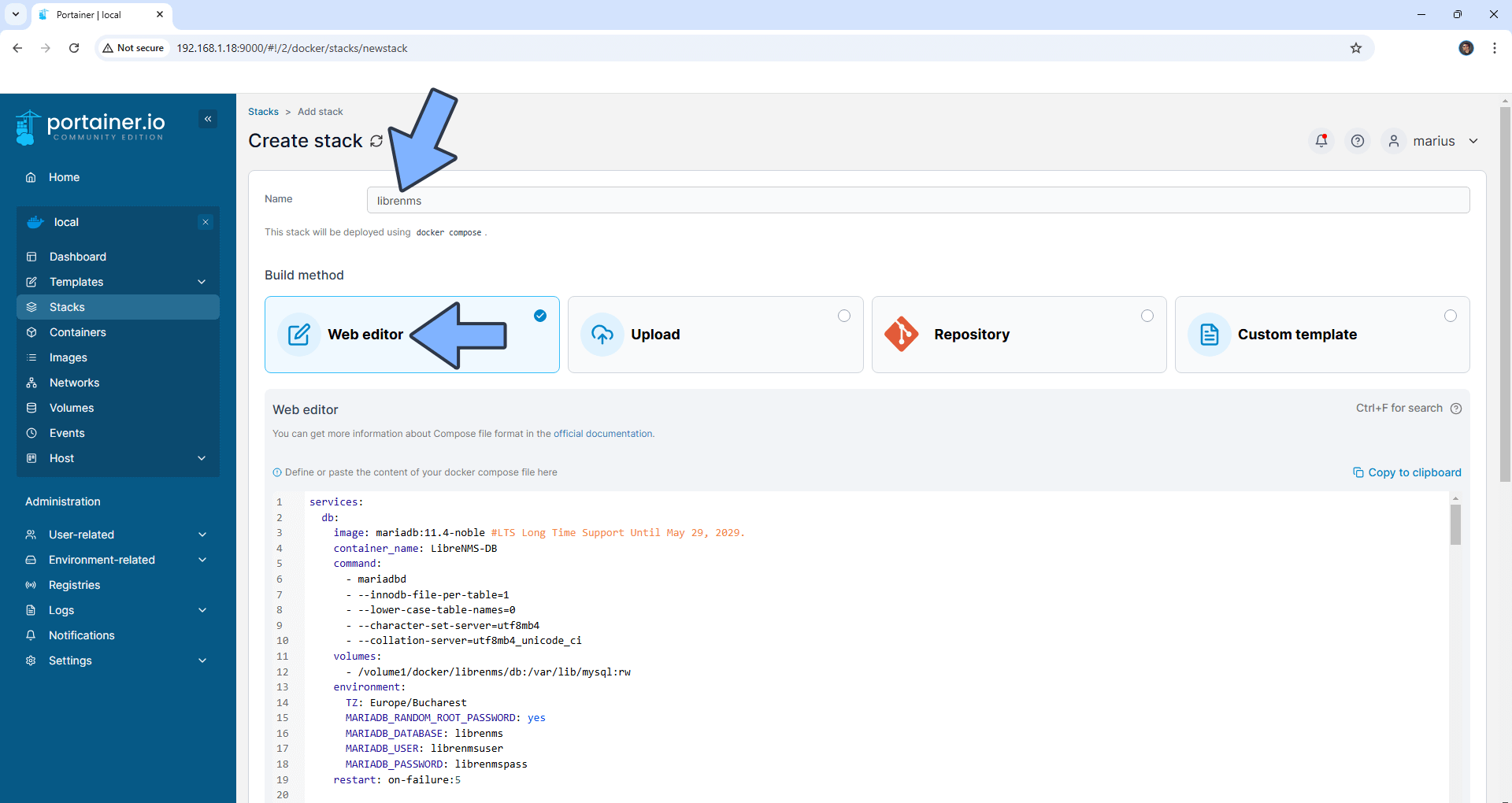
STEP 15
Scroll down on the page until you see a button named Deploy the stack. Click on it. Follow the instructions in the image below. The installation process can take up to a few minutes. It will depend on your Internet speed connection.
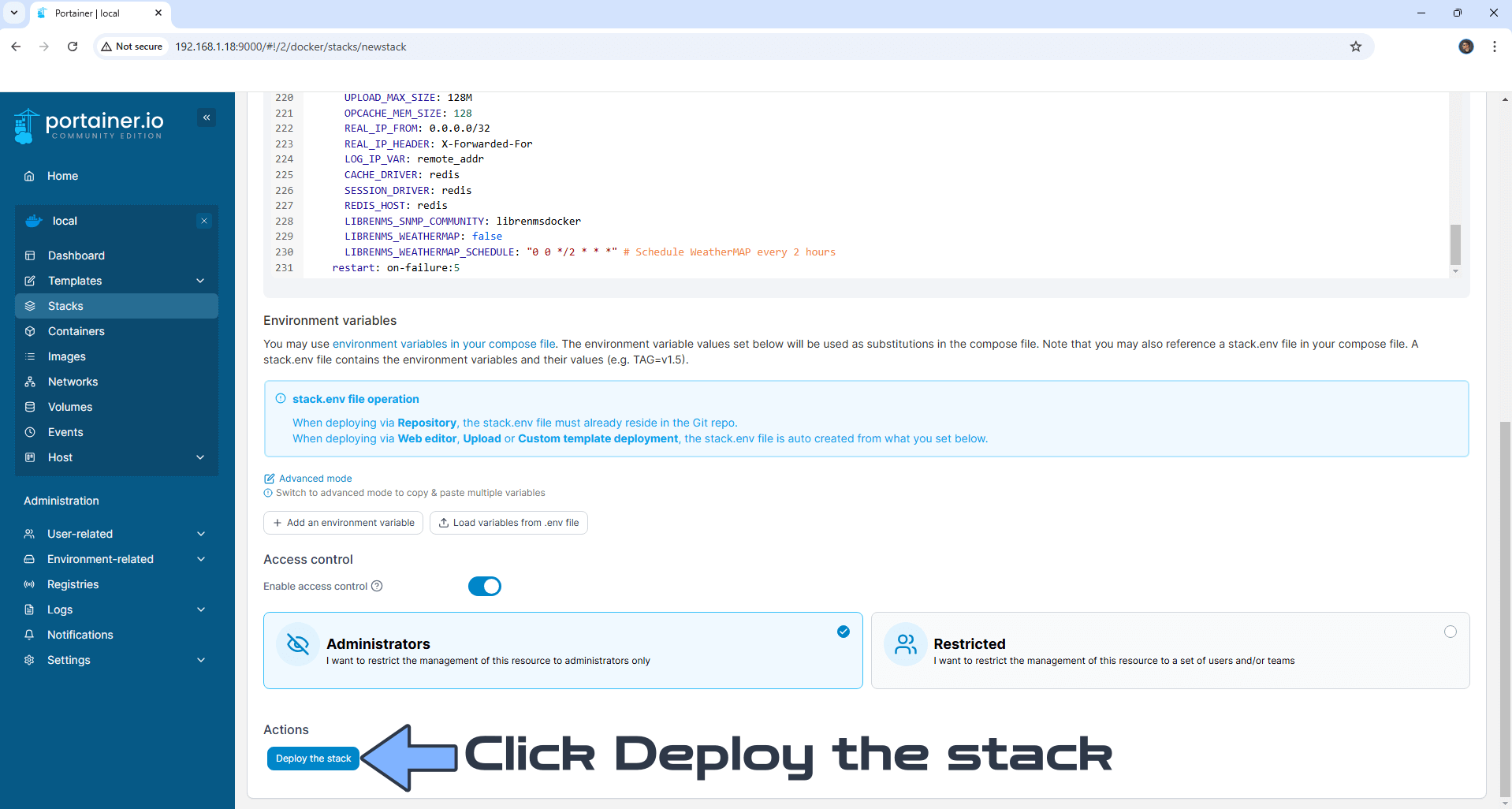
STEP 16
If everything goes right, you will see the following message at the top right of your screen: “Success Stack successfully deployed“.

STEP 17
🟢Please Support My work by Making a Donation. Almost 99,9% of the people that install something using my guides forget to support my work, or just ignore STEP 1. I’ve been very honest about this aspect of my work since the beginning: I don’t run any ADS, I don’t require subscriptions, paid or otherwise, I don’t collect IPs, emails, and I don’t have any referral links from Amazon or other merchants. I also don’t have any POP-UPs or COOKIES. I have repeatedly been told over the years how much I have contributed to the community. It’s something I love doing and have been honest about my passion since the beginning. But I also Need The Community to Support me Back to be able to continue doing this work.
STEP 18
Please wait approximately 10 minutes or you will get a blank synology error page if you try to connect too soon. Now open your browser and type in your HTTPS/SSL certificate like this https://librenms.yourname.synology.me that you have previously created at STEP 6. In my case it’s https://librenms.mariushosting.synology.me If everything goes right, you will see the LibreNMS installation page. Type in your own Admin User details, then click Add User. Follow the instructions in the image below.
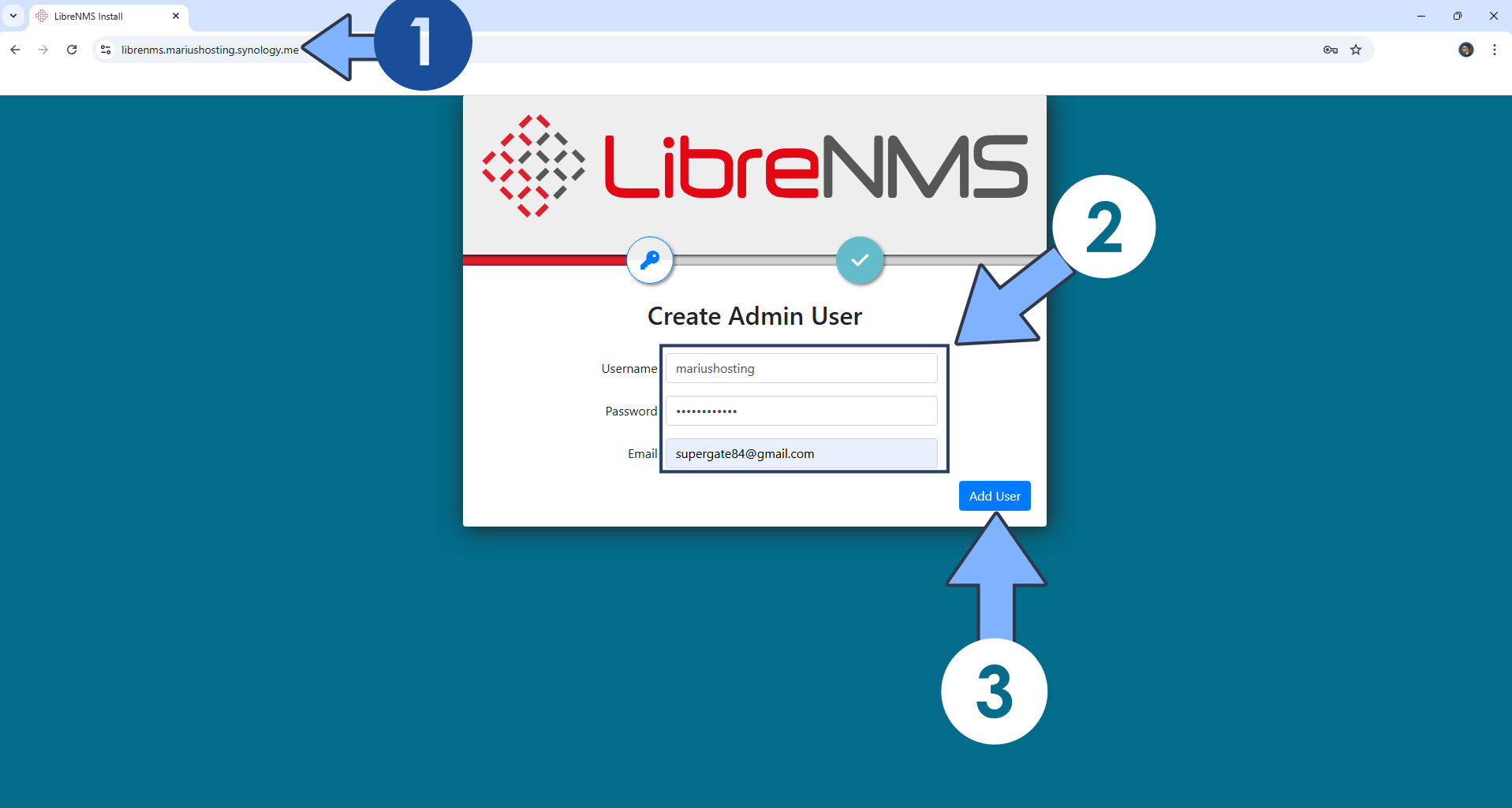
STEP 19
Click the OK icon. Follow the instructions in the image below.
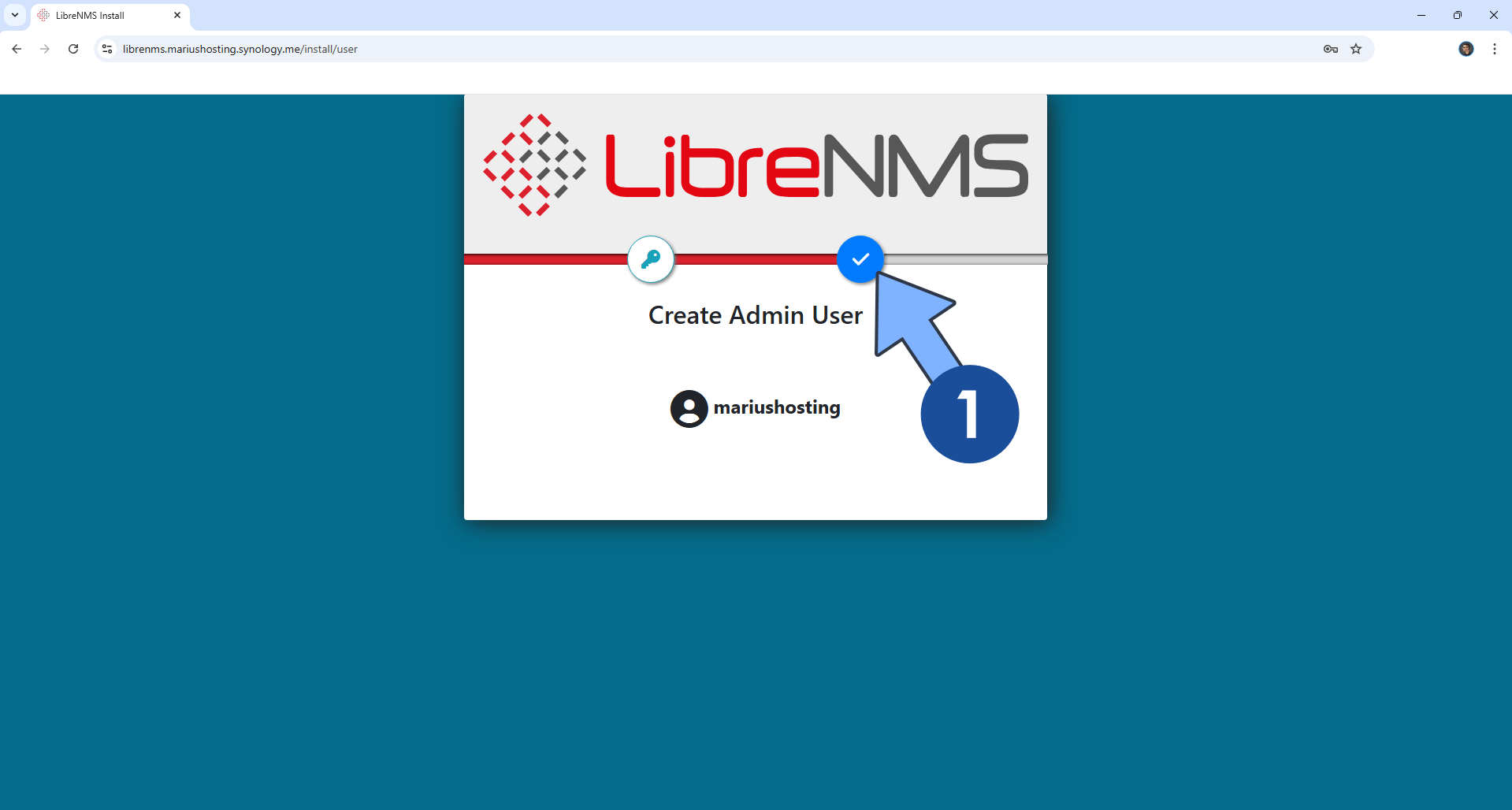
STEP 20
Choose your favorite theme, then click Finish Install. Follow the instructions in the image below.
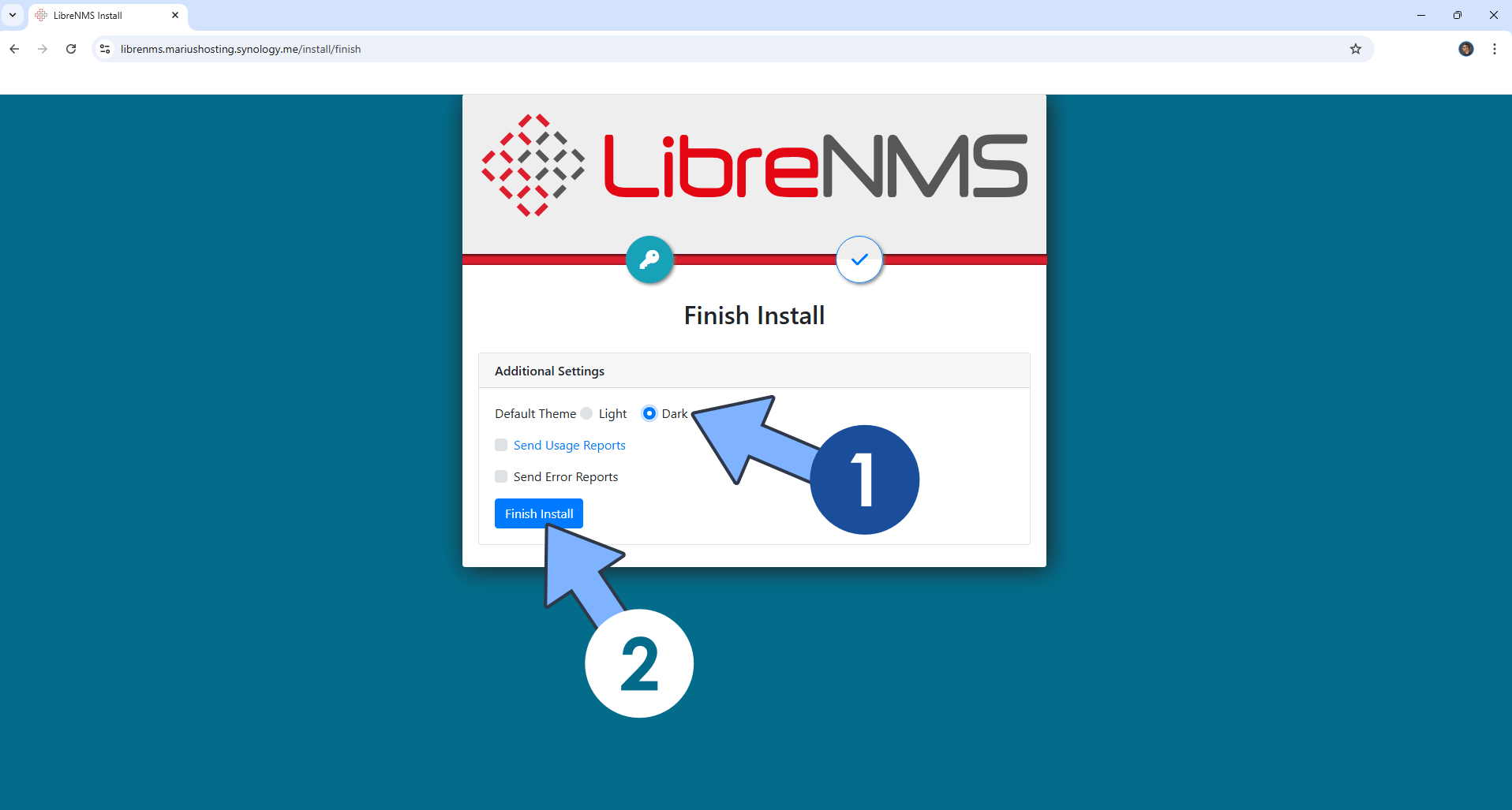
STEP 21
Click Dashboard. Follow the instructions in the image below.
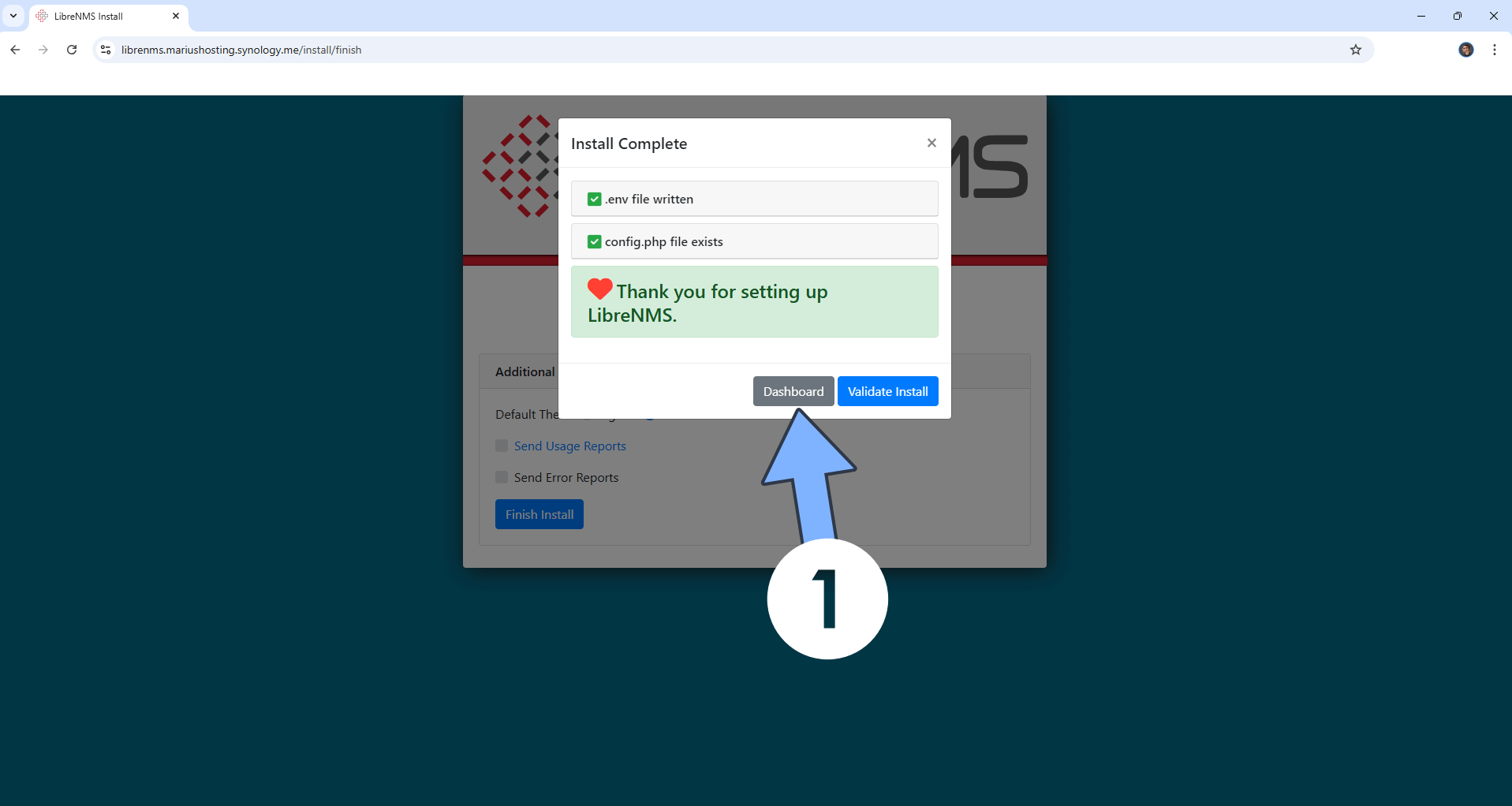
STEP 22
You will be prompted to type in your own username and password that you have previously created at STEP 18. Click Login. Follow the instructions in the image below.
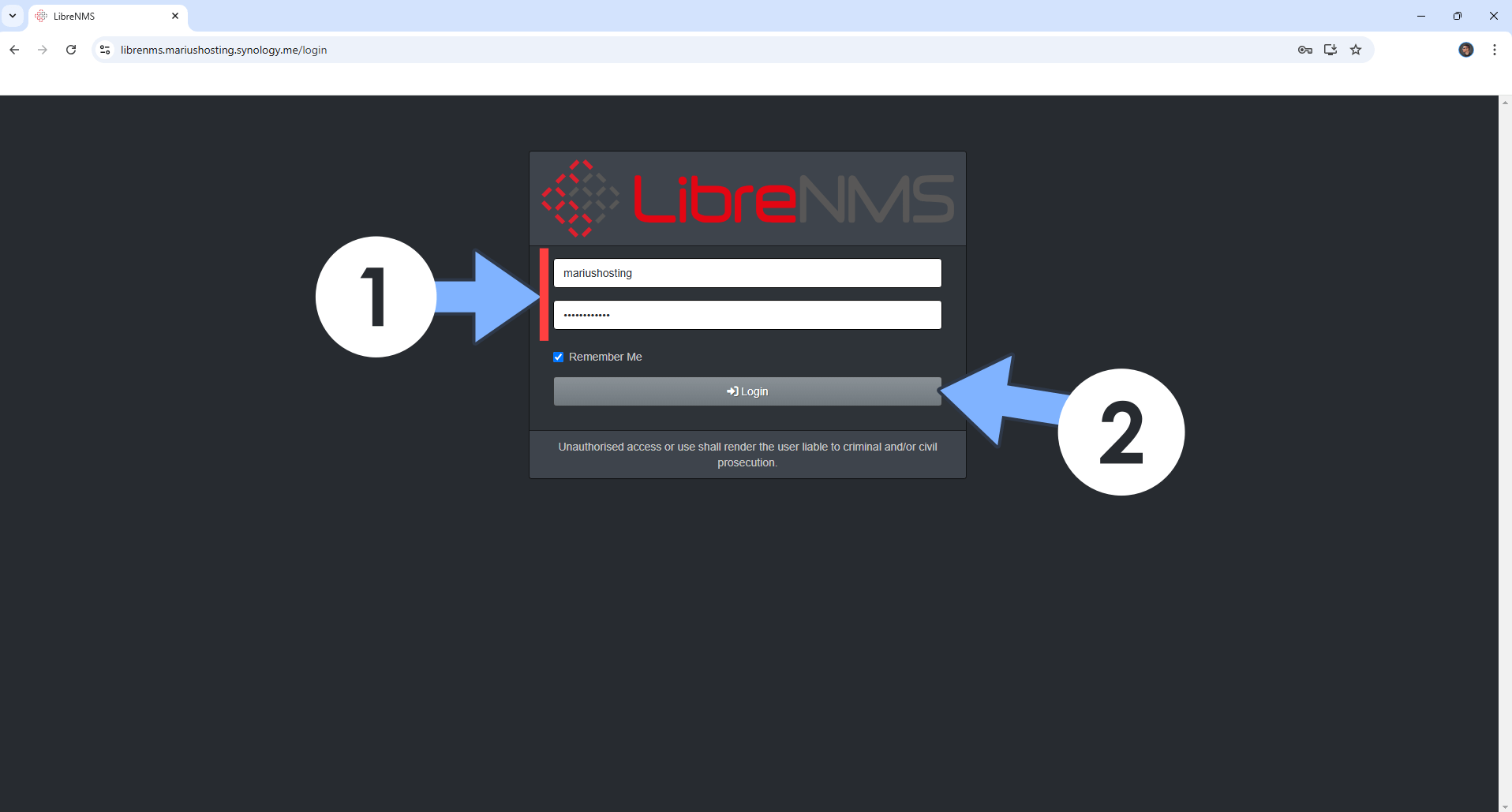
STEP 23
At the top right of the page, click on the gear icon, then Global Settings. Click on the System tab. In the Specific URL area, type in your own synology.me DDNS with https:// at the beginning that you have previously created at STEP 6. Follow the instructions in the image below.
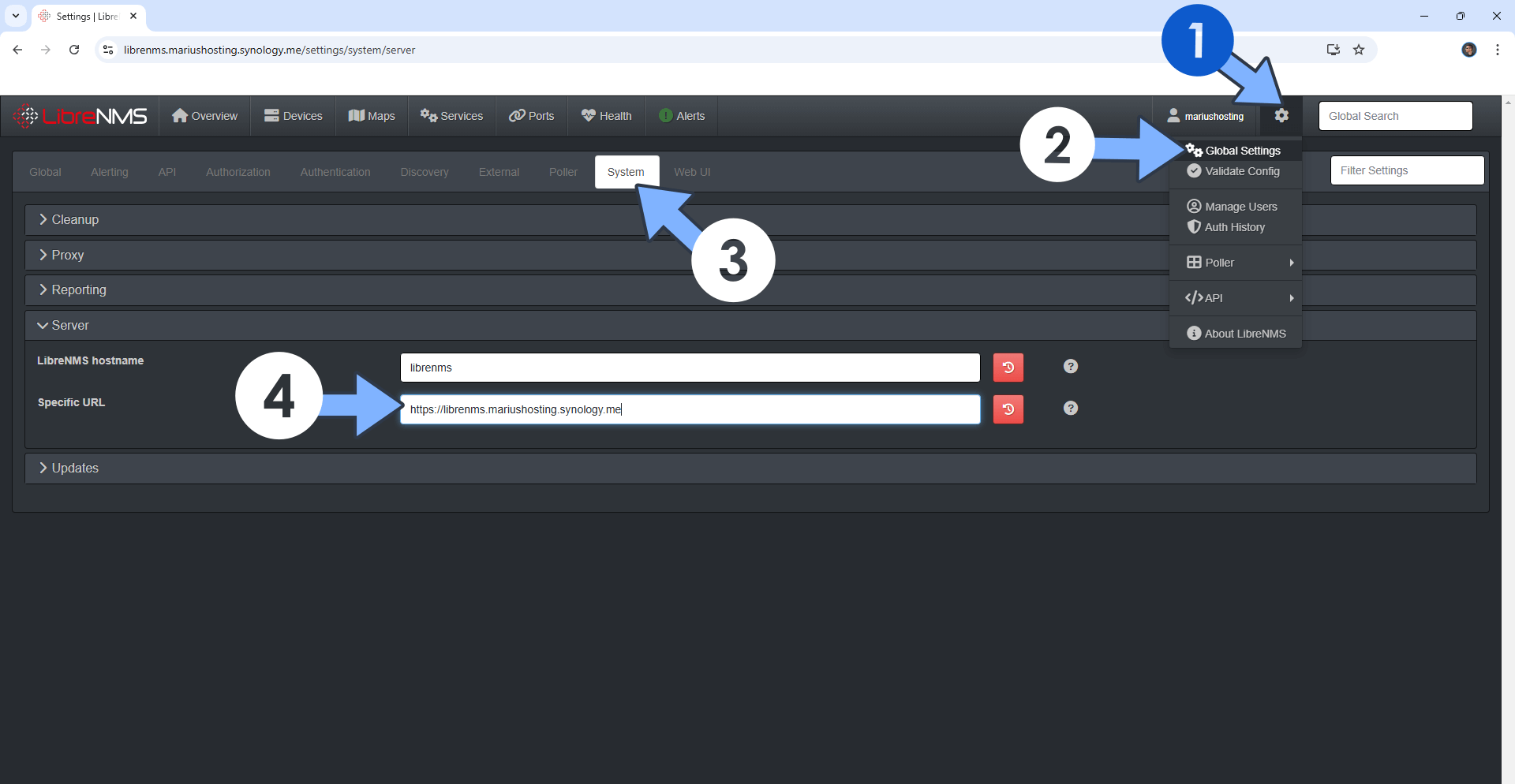
STEP 24
Your LibreNMS dashboard at a glance!
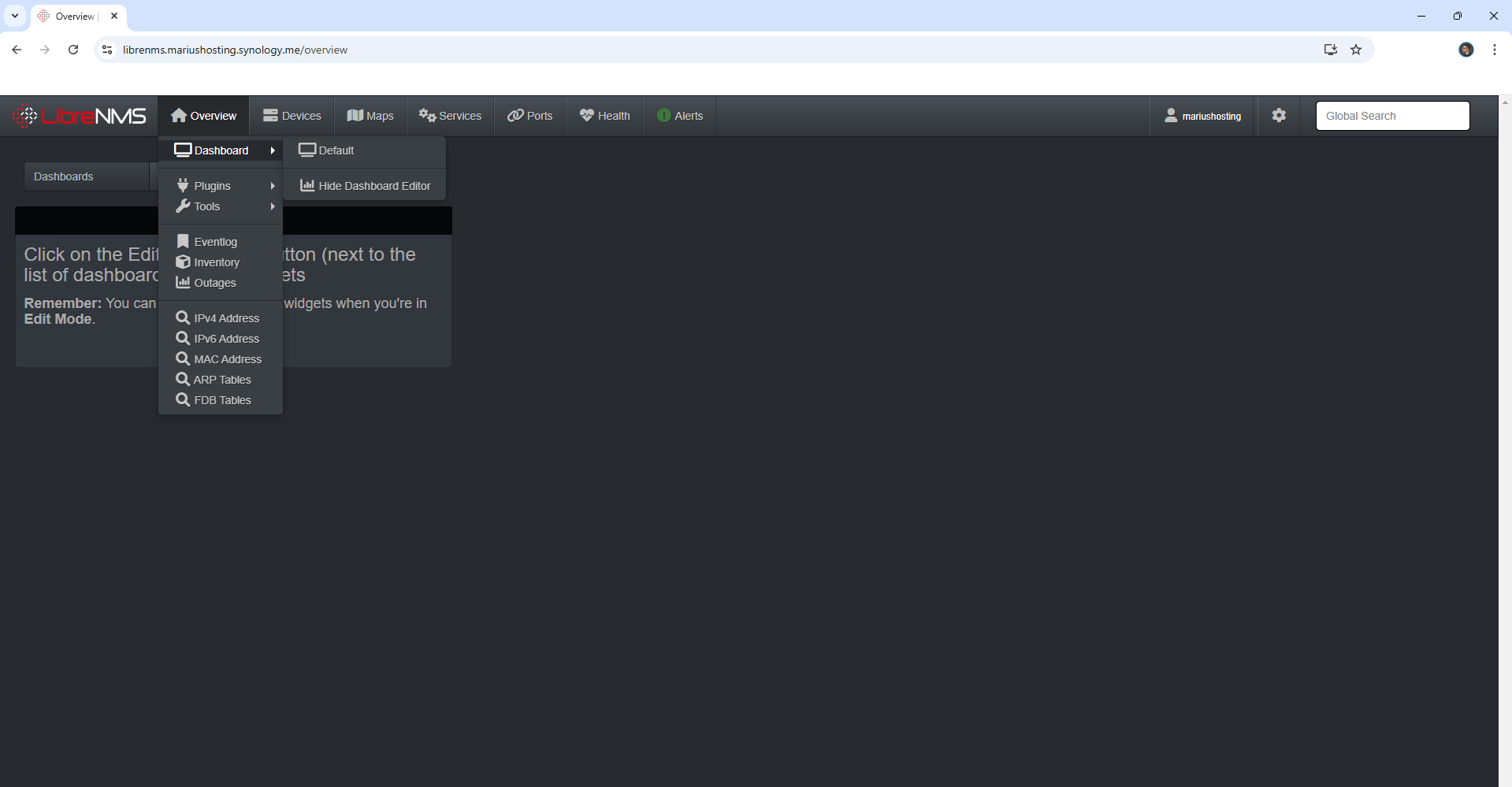
STEP 25
Monitor your Synology NAS via LibreNMS.
Go to Control Panel / Terminal & SNMP / Click on the SNMP tab.
Select Enable SNMP service.
Select SNMPv3 service.
Type in a Username in the SNMPv3 area. You will need this username later at STEP 28.
Protocol select SHA. You will need this parameter later at STEP 28.
Type in a Password. You will need this password later at STEP 28.
Click Apply. Follow the instructions in the image below.
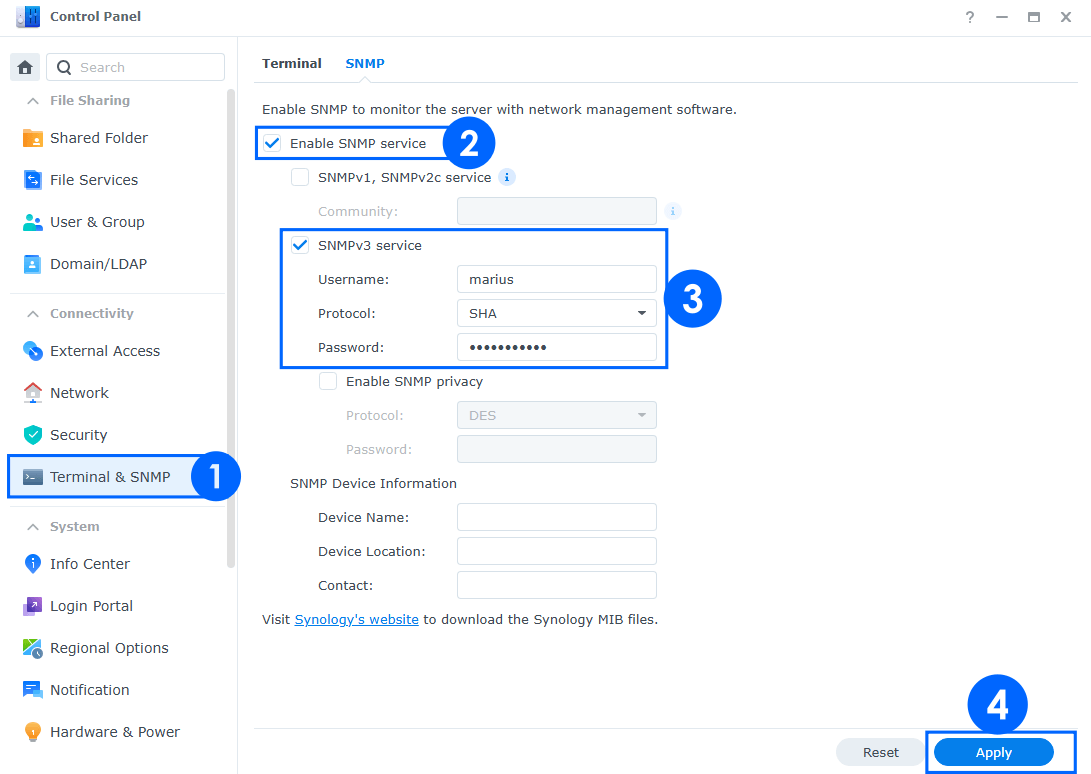
STEP 26
🟢Please Support My work by Making a Donation. Almost 99,9% of the people that install something using my guides forget to support my work, or just ignore STEP 1. I’ve been very honest about this aspect of my work since the beginning: I don’t run any ADS, I don’t require subscriptions, paid or otherwise, I don’t collect IPs, emails, and I don’t have any referral links from Amazon or other merchants. I also don’t have any POP-UPs or COOKIES. I have repeatedly been told over the years how much I have contributed to the community. It’s something I love doing and have been honest about my passion since the beginning. But I also Need The Community to Support me Back to be able to continue doing this work.
STEP 27
Adjust your Synology Firewall in Control Panel / Security / Firewall. Allow the SNMP service on port 161.
STEP 28
Open LibreNMS. Click the Devices tab, then +Add Device. Type in the following parameters:
Hostname or IP: 172.17.0.1
SNMP: ON
SNMP Version: v3
Port: 161
Protocol: udp
Auth Level: authNoPrv
Auth User Name: Your own username that you have previously added at STEP 25.
Auth Password: Your own password that you have previously added at STEP 25.
Auth Algorithm: SHA. This is the Protocol that you have previously chosen at STEP 25.
Click Add Device.
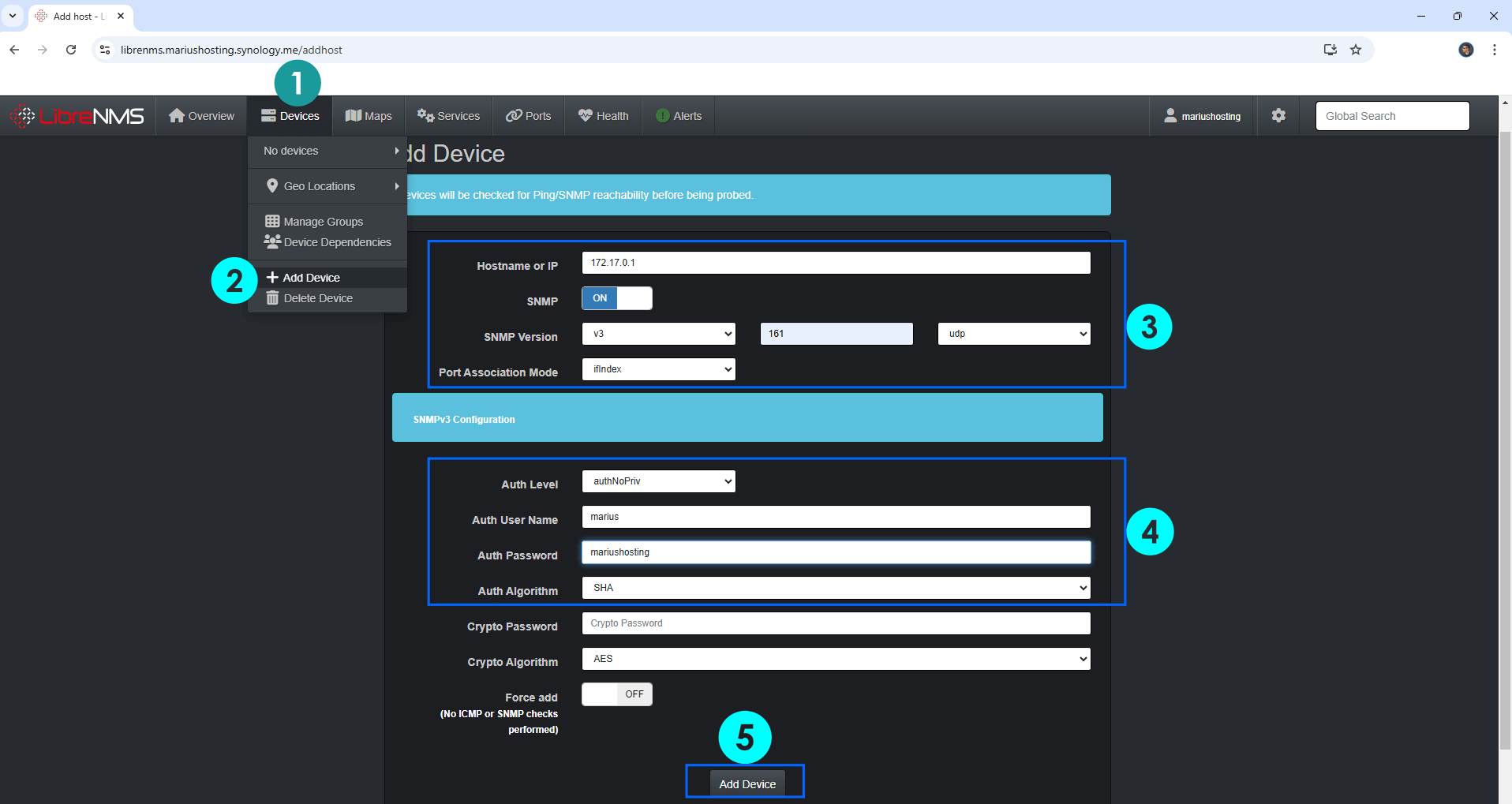
STEP 29
The device will be added in a couple of seconds. If you experience any issue when adding your Synology NAS device, this means you forgot STEP 27.
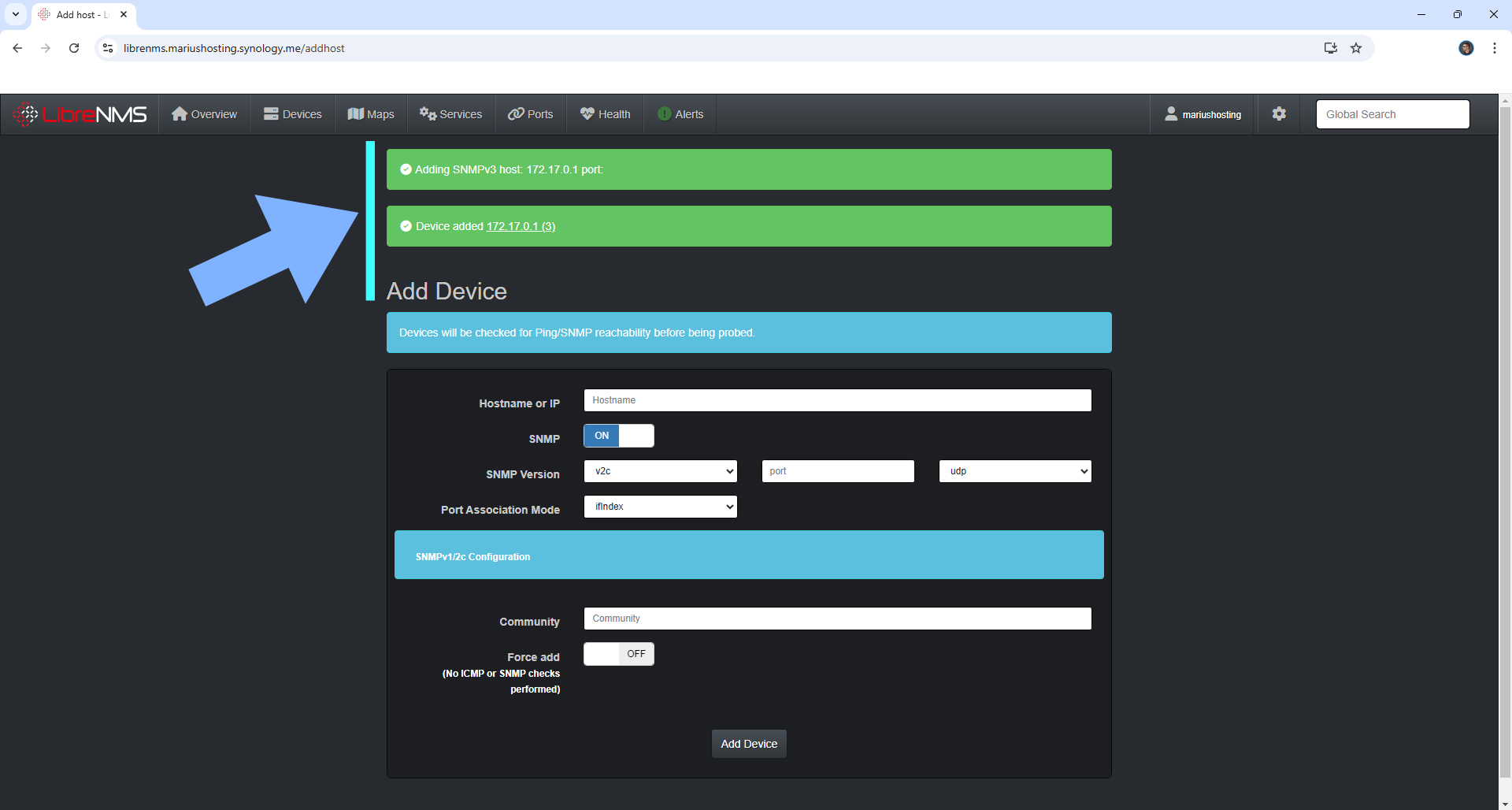
STEP 30
Click Device, then All Devices then Storage. Follow the instructions in the image below.
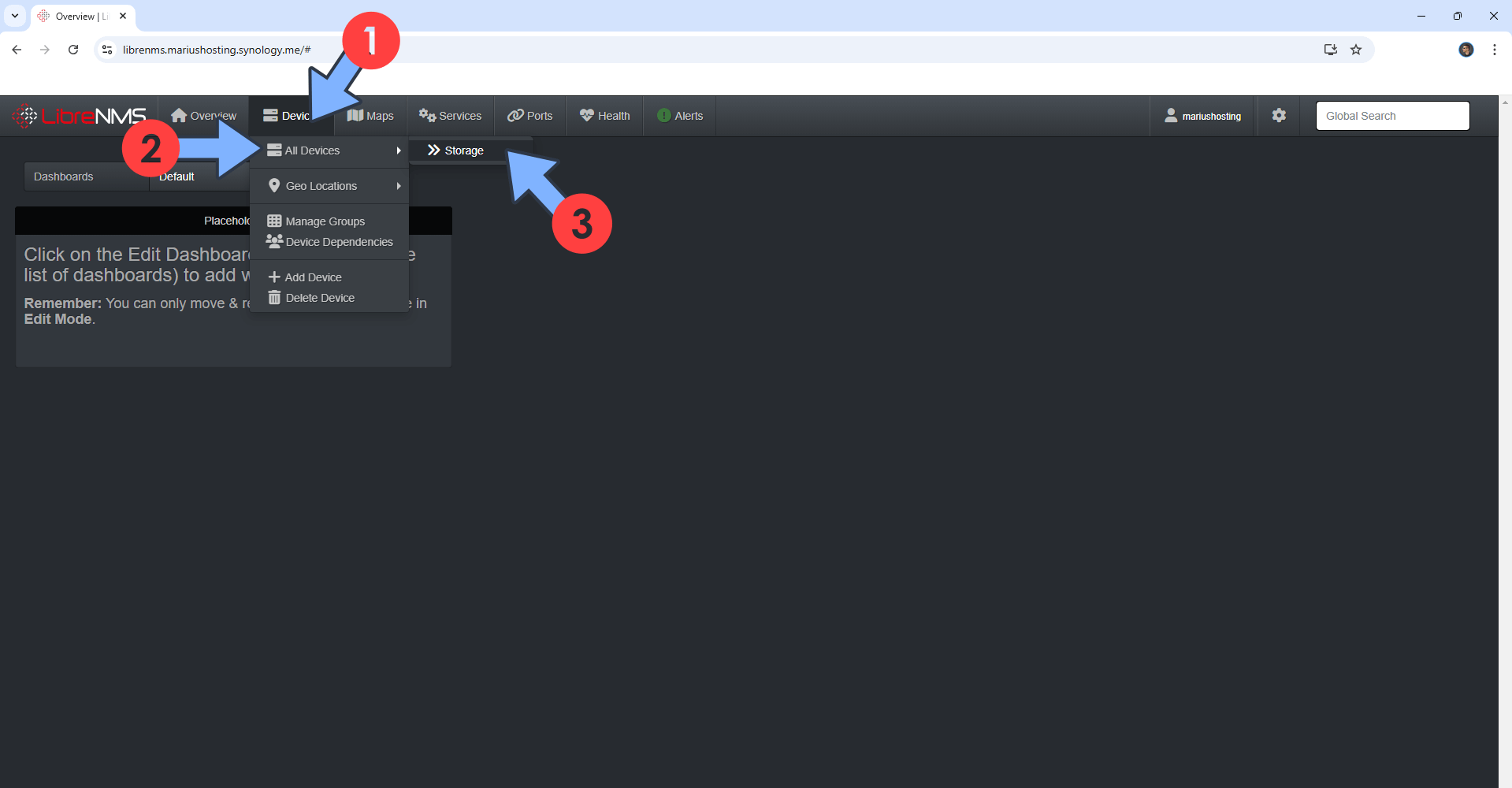
STEP 31
Click on your NAS name. Follow the instructions in the image below.
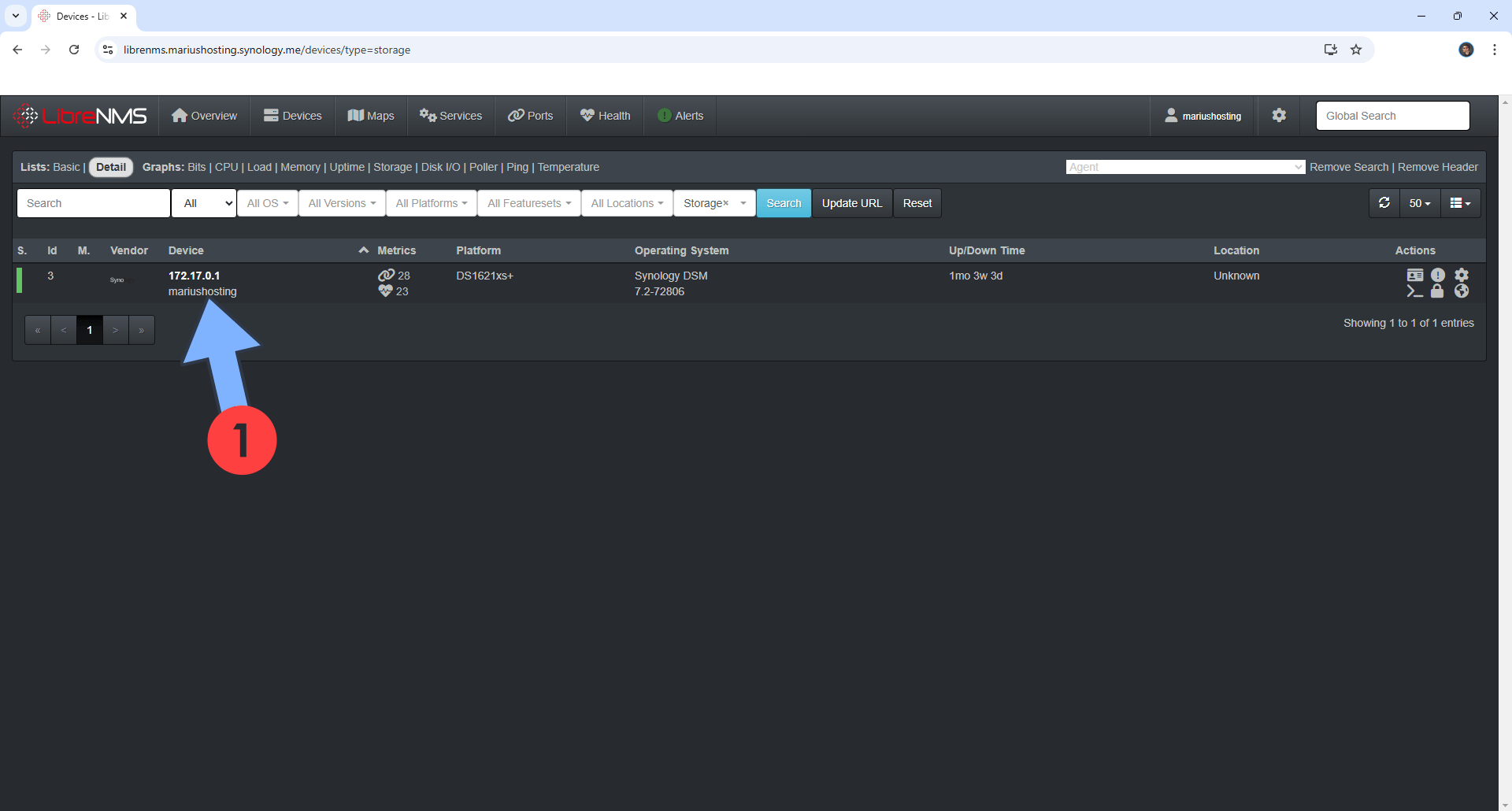
STEP 32
Very important STEP. Your graphs and data need a minimum of 15-20 minutes before they are displayed without issues in LibreNMS. If you don’t wait and are in a hurry, you will get several errors in the graphs, like images not being displayed etc. You need to wait almost 15 minutes for the data from your NAS to synchronize in LibreNMS.
STEP 33
Your Magical Graphs at a glance! Click Graphs!
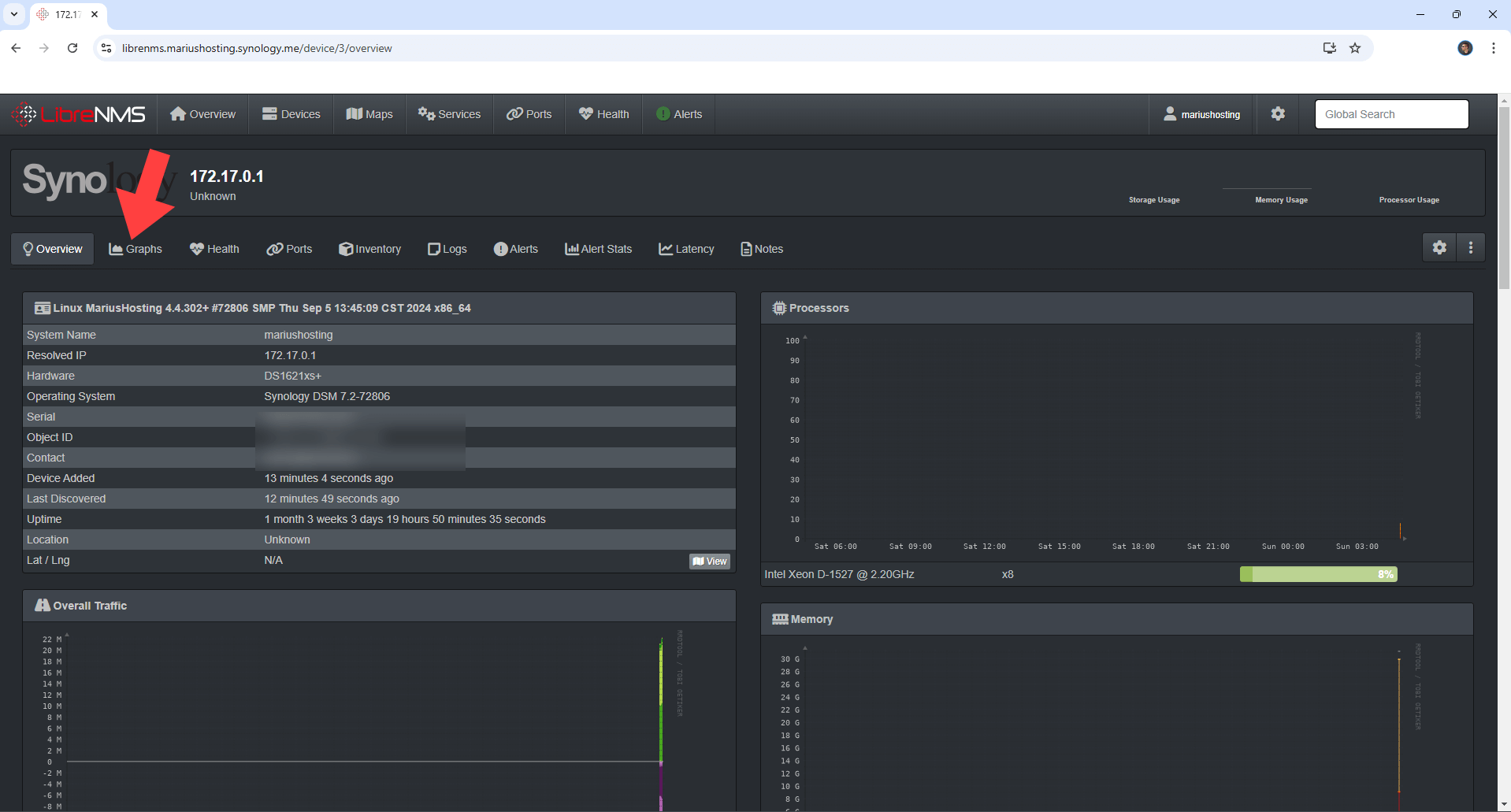
Enjoy LibreNMS!
If you encounter issues by using this container, make sure to check out the Common Docker issues article.
Note: Can I run Docker on my Synology NAS? See the supported models.
Note: How to Back Up Docker Containers on your Synology NAS.
Note: Find out how to update the LibreNMS container with the latest image.
Note: How to Free Disk Space on Your NAS if You Run Docker.
Note: How to Schedule Start & Stop For Docker Containers.
Note: How to Activate Email Notifications.
Note: How to Add Access Control Profile on Your NAS.
Note: How to Change Docker Containers Restart Policy.
Note: How to Use Docker Containers With VPN.
Note: Convert Docker Run Into Docker Compose.
Note: How to Clean Docker.
Note: How to Clean Docker Automatically.
Note: Best Practices When Using Docker and DDNS.
Note: Some Docker Containers Need WebSocket.
Note: Find out the Best NAS Models For Docker.
Note: Activate Gmail SMTP For Docker Containers.
This post was updated on Tuesday / November 25th, 2025 at 2:43 PM
